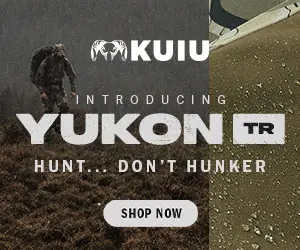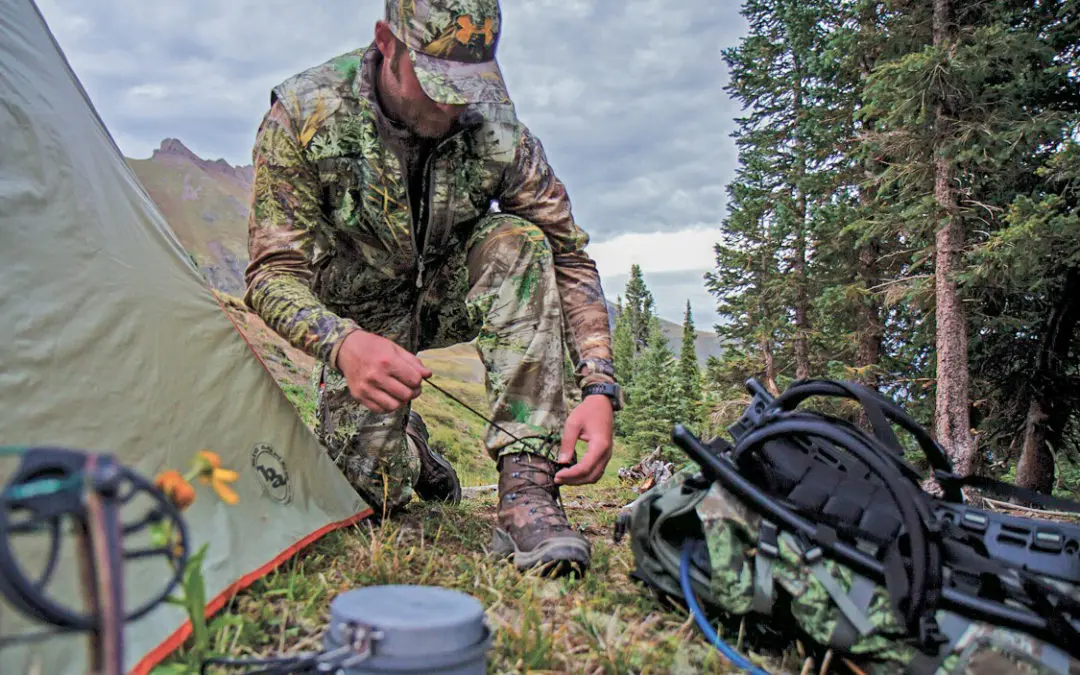
NOTICE: Certain links on this post may earn a commission for Western Hunter Magazine from Amazon or our other affiliate partners when you make a purchase. Thank you for your support.
One Foot at a Time
Prevention and treatment for the one thing that can instantly cripple your hunt.
My most miserable backcountry hunts haven’t been caused by bad weather or heavy packs; nope, they almost all involved blisters on my feet. Sounds like a little thing just talking about it and it’s kind of uncomfortable when you get one on a day hike, but on a backpack hunt in elk country, it can change the entire hunt. Unlike other types of hunts where there may be other means to get from one place to the next, on a backpack hunt there is only hiking, and a blister will remind you it’s there every step you take. Finding time on a backpack hunt to rest a blister and let it heal isn’t an option either (that could take days!), so the best medicine is obviously to prevent them in the first place. So, I’m going to share two things in this article – 1) some tips on prevention; and 2) how to care for your feet if you still end up with a blister.
Prevention
Boot selection
Quality boots on a backpack hunt are just as important as good binoculars and packs; probably more so. When you skimp on boots, you risk wearing a boot that will leak sooner (if not immediately), blow a seam out, and/or not give you proper fit/support – all of which can quickly lead to blisters. Stick with reputable brands and don’t just get whatever is in the bargain bin.
Beyond the brand, try and match a boot to the type of backpack hunt you’ll be doing most often. Do you hunt mainly early season in August and September or October and November? Geographic location is another major factor. The boots I would select for an Alaska backpack hunt in August are not going to be the same boots I’d pick for a backpack hunt in Nevada during the same timeframe. Due to heat and sweat, for early-season warm weather hunts I usually prefer a mixture of leather and synthetic uppers so my feet can breathe better.
Break ‘em in
Properly breaking in your boots is just as important as the purchase. While some boots break in fast, other may take some time. Wear your new boots often around the house, but also get some more serious hiking in on uneven terrain to make sure they’re not giving you any hotspots. I’ve made the mistake before of getting a false sense of security after wearing some new boots around the house and then getting my feet slashed on a hunt when I hit some harsh terrain for the first time with the boots.
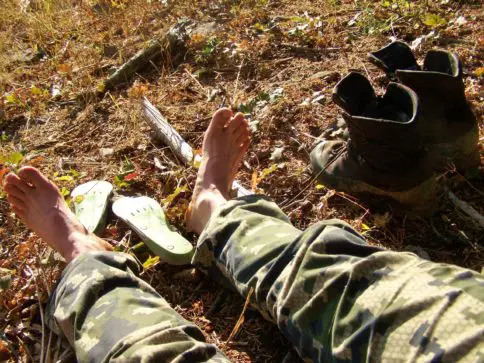
Socks
Good socks wick moisture away from your feet, helping to keep them dry. Cotton socks don’t cut it on backpack hunts – ever. You should look for synthetics like nylon and polypropylene and my favorite combo is a synthetic/wool combo sock. I have had great success with Bridgedale Trail Socks and Smartwool socks, but the Bridgedales last longer for me. These types of materials or combination of them breathes much better than cotton and transfers moisture away from your skin.
Pack multiple pairs (I usually pack three on a backpack hunt), especially if your feet sweat much. Being able to rotate socks on a daily basis really helps keep the inside of your boots drier. I usually change out a pair each night before bed, and if it’s warm enough I sleep with no socks to air my feet out well. If we’ll be coming back to a camp, I’ll set the socks I used on a branch to dry out while I’m out hunting. If you’re camped next to a creek, then rinse the used pair out real well before hanging them to dry.
Quality aftermarket insoles
This is another step you can take that has more to do with providing good support and keeping your feet from getting fatigued from heavy pack weights, but they also provide extra support that helps keep your feet in place and not sliding around inside when on uneven terrain. I’ve used several good insoles, but I’m a fan of the orange Superfeet.
Pre-hunt clip
Trimming your toenails before a hunt is a must in order to reduce potential toe pain and also avoid more possible blisters.
Internal moisture management
Moisture management is tough, because you have to deal with it from both inside and out.
It’s a good idea to remove the insoles each night to aid drying more thoroughly, because there is moisture trapped underneath the insole. However, don’t make the mistake of leaving your boots out to dry at night without making sure they are under your vestibule or some sort of cover. Even if it’s nice weather, you’ll often get enough dew at night to cause some unnecessary moisture build-up in your boots.
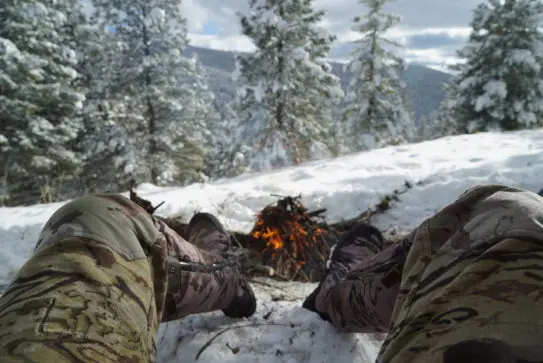
Try and let your feet and boots air out as often as possible during the day. Anytime I stop to glass, eat, or rest for at least ten minutes, I at least unlace my boots at least and ideally remove my boots to allow moisture to escape.
We’ve discussed how to dry things out a little, but you can also minimize the amount of moisture with foot powders and even antiperspirants. I douse the inside of my boots with foot powder at the trailhead, and on extremely warm hunts I’ll pack a travel-size powder dispenser. Foot powder not only absorbs moisture, but also helps control odor! I’ve used Gold Bond with good results and when I’m feeling particularly psycho about scent control, I add Scent Killer foot powder in as well. There are also good foot antiperspirant products available. I’ve used some of the unscented roll-on types and it worked well enough, but it wears off quickly.
Dealing with Mother Nature
The other moisture you fight is all the ways Mother Nature dishes it up. You really have to be extra carful with this one, because sweat will seem like nothing if you fall in a creek or are unprepared for a rainstorm. Rain can be a disaster that can leave you with wet feet for the rest of the hunt, with no surefire way to dry your boots in the backcountry.
It’s mostly common sense stuff, but don’t underestimate things like how much water is left sticking to the plants after a quick rain squall that only lasted a few minutes. Keep your rain pants or gaiters with you all the time and don’t get lazy; use them! I hate putting them on and taking them off, but I’ve learned too many lessons the hard way.
If your boots get soaked all the way through, it’s going to be a long hunt, especially with limited heat sources. Drying boots next to an open campfire isn’t a real good option; I’ve melted the rubber rand on accident, causing it to shrink and smash my toes, giving me blisters when hiking out five miles just to get fresh boots.
Boots are best dried from the inside out, which is tough in the backcountry. One of the best things you can do is slip some heat packets into them if you carry them. This is as good a chance to dry them out without damaging them as you might get. You can also wrap them up and sleep with them inside your sleeping bag get a small amount of additional heat, but it isn’t exactly cozy.
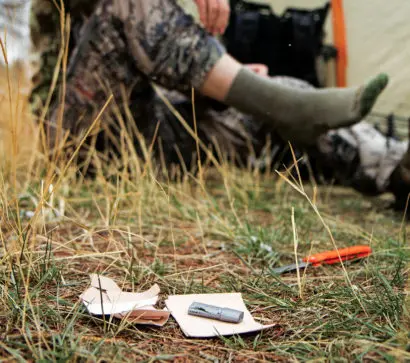
Treatment
You should really start taking steps the moment you start to feel a hotspot. Do not wait until you have a serious blister! Adjust your socks, cover the area with some protective layer, or whatever it takes.
Should you end up with one - and I’ve had my fair share - here are some items I pack with me that perform well:
- 2nd Skin Adhesive Knit is my favorite. It’s fairly thin, breathable, flexible, and does a good job of staying in place throughout the day, even when sweating. They also make padded blister treatments, but I’ve found that most of the padded option rolls up on my boot faster.
- Moleskin (non-padded) is another product I take along, as it offers just a little more cushion in case I get a blister in a spot where I might want a little more cushion, such as between toes.
- Finally, I pack I small amount of duct tape. It can be used for a variety of purposes, but it works well if I need some extra attention on keeping some 2nd Skin or moleskin in place if it’s in a tough spot. I also, use duct tape on hotspots and keep the other stuff for if I actually get a blister. I don’t like duct tape directly over blisters and since it doesn’t breathe well, it’s not ideal for healing. Even when using the 2nd Skin and moleskin, it’s best to remove it each night to allow air in and then replace it with a clean piece the next morning.

